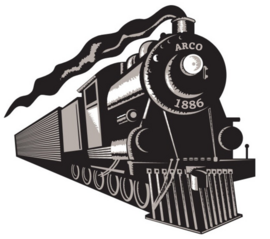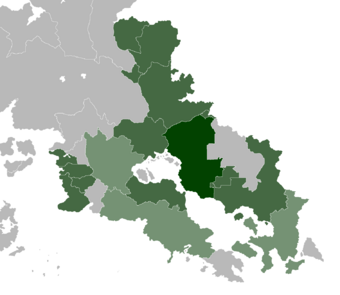Arco National Railway Service: Difference between revisions
mNo edit summary Tag: 2017 source edit |
|||
| (6 intermediate revisions by one other user not shown) | |||
| Line 1: | Line 1: | ||
{{Infobox rail | {{Infobox rail | ||
| railroad_name = Arco National Railway Service (ANRS) | | railroad_name = Arco National Railway Service (ANRS) | ||
| logo = | | logo = Arco Rail Logo V2.PNG | ||
| system_map = | | system_map = ArcoRailServiceMap.PNG | ||
| map_caption = | | map_caption = {{legend|#006400|Arcerion}}{{legend|#228B22|Current nations with Arco Rail Services}}{{legend|#8FBC8F|Planned Expansions}} | ||
| marks = ARNS | | marks = ARNS | ||
| locale = [[Arcerion]]</br>[[Washakara]]</br>[[Paulastra]]</br>[[Kelekona]]</br>[[Titechaxha]]</br>[[Alstin]] | | locale = [[Arcerion]]</br>[[Washakara]]</br>[[Paulastra]]</br>[[Kelekona]]</br>[[Titechaxha]]</br>[[Alstin]] | ||
| Line 22: | Line 22: | ||
== History == | == History == | ||
The predecessor to the Arco National Railway Service was [[Easthampton Railways]]. It was set up by the [[Arcerion Steel Corporation]] as a subsidiary to help with the migration of labourers to [[Easthampton]], Arcerion. It sent the first finished pieces of steel to ports from the factories to Chester-on-Moore to be shipped overseas to [[Burgundie]] in 1851. It continued as a small railway with only two tracks and a limited number of locomotives until the massive expansion of the railway in 1886 and the amalgamation of Easthampton Railways by the Crown Governor [[William Walter James|Sir William Walter James]] of Arcerion, who ordered the Secretary of the Treasury to form a committee on the expansion of railways in Arcerion. | |||
The founding in 1886 was accompanied by massive booms in Arcerion's population, economic expansion, and infrastructure. The first new ANRS rail line was set from Port Hughes in the South to [[Dunborough]] in the North, with a second newer line set up to Easthampton to help ship the vast quantities of iron ore and steel products being manufactured in the town. Rosmore Station in Kurst continued to grow until it was the largest rail hub and station in Arcerion by 1900, and by the 1920s it was the largest in Crona. | |||
The [[Arcer Heartland]] was chiefly settled along the ANRS lines that led into the future [[Northlea Governorate]]. Trains carried settlers, provisions, soldiers, horses, cattle, and manufactured goods necessary to conquer the wilderness and rolling grasslands of the centre of Arcerion. Small fortified towns and stations began to pop up along the rail line, ending with the final major colonial junction in [[Presdale]]. | |||
During the Great Wars, the railway service also saw the introduction of military railway troops, armoured trains, and carried provisions to Easthampton to assist with the ongoing [[Washakara|Washakaran]] campaign against [[Paulastra]]. During the wars, the railway saw massive expansions in its rail lines to the South, and [[Moorden Governorate|Moorden]] and [[Norham Governorate|Norham]] were the chief governorates to benefit from the wars, as rail brought with it increased Parliamentary funding and labour. | |||
== Facilities == | == Facilities == | ||
The Arco National Railway System has hundreds of yards, warehouses, switching stations, passenger stations, and freight loading centres. Mostly, these facilities are used for rail switching to allow for traffic control on the tracks. There is also intermodal transport types, such as the sprawling combination wharf-railyard in Chester-on-Moore that allows for the transfer of sea containers to railcars and raw goods such as coal or iron ore to commercial freight vessels. There is also truck-rail hubs for the transfer of rail freight to large transportation trucks, however these are usually found further inland in Arcerion where there is less minor rail infrastructure, thus a reliance more on heavy and medium transportation trucks. | |||
== Track and Lines == | == Track and Lines == | ||
| Line 57: | Line 45: | ||
[[Category: Arcerion]] | [[Category: Arcerion]] | ||
{{Template:Award winning article}} | |||
[[Category:2023 Award winning pages]] | |||
[[Category:IXWB]] | |||
[[Category:Railways]] | |||
Latest revision as of 16:03, 19 January 2024
The Arco National Railway Service (reporting marks ARCO, AN) is a Class I government-owned freight-hauling railroad that operates over 2,000 locomotives over 50,000km of routes in thirteen different Cronan countries. It is the largest freight railroad in South Crona in terms of track length, freight hauled, passengers carried, and locomotives/cars used. Its subsidiary, Southern Railways is one of the largest and most extensive passenger rail lines in South Crona.
 | |
 Arcerion Current nations with Arco Rail Services Planned Expansions | |
| Overview | |
|---|---|
| Headquarters | 1 Railway Avenue, Commerce District, Kurst Capital Region, Arcerion |
| Reporting mark | ARNS |
| Locale | Arcerion Washakara Paulastra Kelekona Titechaxha Alstin |
| Dates of operation | May 1, 1886–present |
| Predecessor | Easthampton Railways |
| Technical | |
| Track gauge | 1,435 mm (4 ft 8+1⁄2 in) |
| Length | TBD |
| Other | |
| Website | www.arns.arc |
Founded in 1886, Arco National Railway Service was part of the first transcontinental railroad in South Crona, with locomotives purchased in pieces from Levantia and shipped and assembled in Kurst. Over the next several decades, the speed and breadth of the railway's expansion meant that there was little to no direct competition to its construction. It was the first railroad to expand across the Malentine Basin, as well as into Central Crona. It notably never had lines or routes extending into Varshan. As of the end of the Second Great War it remained the largest railway in South Crona. There continue to be expansion plans into the Southwestern Cronan Peninsula as well as along the newer Northern routes towards the Albion Sea. The railway remains at its original headquarters in Kurst, although the building, the Confederation Railway Station, has undergone multiple renovations and expansions.
History
The predecessor to the Arco National Railway Service was Easthampton Railways. It was set up by the Arcerion Steel Corporation as a subsidiary to help with the migration of labourers to Easthampton, Arcerion. It sent the first finished pieces of steel to ports from the factories to Chester-on-Moore to be shipped overseas to Burgundie in 1851. It continued as a small railway with only two tracks and a limited number of locomotives until the massive expansion of the railway in 1886 and the amalgamation of Easthampton Railways by the Crown Governor Sir William Walter James of Arcerion, who ordered the Secretary of the Treasury to form a committee on the expansion of railways in Arcerion.
The founding in 1886 was accompanied by massive booms in Arcerion's population, economic expansion, and infrastructure. The first new ANRS rail line was set from Port Hughes in the South to Dunborough in the North, with a second newer line set up to Easthampton to help ship the vast quantities of iron ore and steel products being manufactured in the town. Rosmore Station in Kurst continued to grow until it was the largest rail hub and station in Arcerion by 1900, and by the 1920s it was the largest in Crona.
The Arcer Heartland was chiefly settled along the ANRS lines that led into the future Northlea Governorate. Trains carried settlers, provisions, soldiers, horses, cattle, and manufactured goods necessary to conquer the wilderness and rolling grasslands of the centre of Arcerion. Small fortified towns and stations began to pop up along the rail line, ending with the final major colonial junction in Presdale.
During the Great Wars, the railway service also saw the introduction of military railway troops, armoured trains, and carried provisions to Easthampton to assist with the ongoing Washakaran campaign against Paulastra. During the wars, the railway saw massive expansions in its rail lines to the South, and Moorden and Norham were the chief governorates to benefit from the wars, as rail brought with it increased Parliamentary funding and labour.
Facilities
The Arco National Railway System has hundreds of yards, warehouses, switching stations, passenger stations, and freight loading centres. Mostly, these facilities are used for rail switching to allow for traffic control on the tracks. There is also intermodal transport types, such as the sprawling combination wharf-railyard in Chester-on-Moore that allows for the transfer of sea containers to railcars and raw goods such as coal or iron ore to commercial freight vessels. There is also truck-rail hubs for the transfer of rail freight to large transportation trucks, however these are usually found further inland in Arcerion where there is less minor rail infrastructure, thus a reliance more on heavy and medium transportation trucks.
Track and Lines
Locomotives and Rolling Stock
Statistics
Southern Railways
Accidents and Incidents